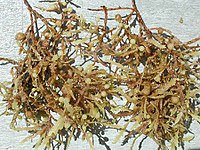
Photo from wikipedia
Seafloor massive sulphide (SMS) deposits, found at water depths to 3600 m, are products of high-temperature hydrothermal activity associated with seafloor volcanism. Dissolved metals in the hydrothermal fluids precipitate when the… Click to show full abstract
Seafloor massive sulphide (SMS) deposits, found at water depths to 3600 m, are products of high-temperature hydrothermal activity associated with seafloor volcanism. Dissolved metals in the hydrothermal fluids precipitate when the fluids are expelled. Metal sulphides also accumulate as chimney-like structures. SMS are considered for future commercial exploitation because of the presence of metals such as Cu, Zn, Au and Ag. Physical parameters (geotechnical and geophysical) of SMS are important for mining purposes, to allow estimation of both the size of the deposits and the amount of ore. This paper investigates the magnetic susceptibility of 40 mini-core samples with respect to the possible discrimination of ore from host rock in the cores immediately after the drilling operations. The unmineralized host rock samples in general have higher susceptibilities compared with the mineralized samples. However, the analysis of the electrical resistivity allows a unique discrimination for our set of samples, as the mineralized and unmineralized samples fall into distinct groups without overlap when both susceptibility and resistivity are considered. The imaginary conductivity, a parameter that quantifies induced polarization, further enhances discrimination between the mineralized and non-mineralized groups.
Journal Title: Quarterly Journal of Engineering Geology and Hydrogeology
Year Published: 2017
Link to full text (if available)
Share on Social Media: Sign Up to like & get
recommendations!